#excel large and small function in excel
Explore tagged Tumblr posts
Text
Befriending And Working With Crows

Crows have long been associated with witches due to their behavior, mystery, and connection to the supernatural. In folklore, they are seen as messengers between worlds, carrying secrets and omens. Witches were believed to communicate with or shape-shift into crows, using them as familiars to gather information or perform magical tasks. Their black feathers and eerie caws made them symbols of transformation, death, and hidden knowledge. This connection persists in modern witchcraft, where crows are often seen as guides for those practicing divination, shadow work, and spirit communication.
Crows are among the most intelligent birds, possessing problem-solving skills, advanced memory, and the ability to use tools. Studies have shown that they can recognize human faces, plan for the future, and even understand cause and effect. Their complex social structures and ability to communicate information indicate a high level of cognitive function, comparable to that of primates. Crows have been observed crafting tools from leaves and twigs, solving multi-step puzzles, and even holding grudges against perceived threats. Their intelligence makes them highly adaptable and capable of thriving in diverse environments.
Crows are highly intuitive, mysterious, and deeply connected to witchcraft, omens, and spirit work. These birds are known for their symbolism in folklore, association with deities like The Morrigan, Odin, and Hekate, and their ability to form strong bonds with humans. Befriending crows can be a rewarding experience, offering companionship, spiritual messages, and even small “gifts” from the birds themselves. Connecting with the crows isn't hard as they tend to be everywhere and their bravery and curiosity makes them willing to approach certain humans. They have senses of humor, empathy, critical thinking skills, and a lifespan of up to 30 years, all of which makes them excellent companions. Get to know the crows in your neighborhood.
🐦⬛Understanding Crow Behavior
Before approaching crows, it's essential to understand their nature:
• They are highly intelligent – Crows can recognize human faces, solve puzzles, and even speak.
• They have strong social bonds – They communicate within their flocks and even warn each other about potential dangers.
• They can be wary – Earning a crow’s trust takes patience, consistency, and respect.
• They have fantastic memories – A crow won't forget the face of a human that was kind to it and especially not that of one who was rude.
🐦⬛Attracting Crows to Your Space
To encourage crows to visit you regularly, follow these steps:
1. Offer Food Consistently
Crows love high-energy foods. Some of their favorites include:
• Unsalted peanuts (in-shell or shelled) – A crow favorite!
• Sunflower seeds – Nutritious and easy to scatter.
• Fruits (apples, grapes, berries) – Fresh or dried.
• Leftover meat scraps – A natural part of their diet.
• Hard-boiled eggs – A great protein source.

What to Avoid:
• Never feed crows processed, salty, or sugary foods.
• Avoid bread – it lacks nutrition.
• Do not leave large amounts of food – too much can attract unwanted pests.
2. Choose a Safe Feeding Spot
• Select a quiet, open area where they feel comfortable landing.
• Keep a routine – feeding them at the same time each day builds trust.
• If possible, create a dedicated offering space, like a small platform.
3. Provide Fresh Water
• A shallow birdbath or bowl of clean water can help attract crows, especially in dry seasons.
• Change the water frequently to keep it fresh.
🐦⬛Earning Their Trust
1. Observe From a Distance
• At first, let crows come and go without interference.
• Avoid sudden movements or loud noises.
• If they seem cautious, step back and let them approach at their own pace.
2. Speak to Them
• Crows recognize human voices and can distinguish between friendly and hostile tones.
• Greet them softly or whistle a simple tune when feeding them.
• Some witches even give their crows names, reinforcing a bond.
3. Leave Small Offerings
• In addition to food, place shiny objects (small trinkets, marbles, beads) as “gifts” for crows.
• Some crows may return the favor by leaving tokens like buttons, feathers, or shells.
🐦⬛Building a Magickal Relationship
Once crows recognize you as a friend, you can incorporate them into your spiritual practice:
1. Crow as a Spirit Ally
• If a crow visits during ritual work or divination, take note—its presence may carry a message.
• Crows can serve as psychopomps, guiding spirits between realms.
2. Divination & Omens
• A single crow cawing may indicate a warning or message.
• A group (a murder of crows) could symbolize change, transformation, or ancestral spirits.
• Here's some more information about counting crows.
3. Offering a Sacred Space
• Create a small altar outside with natural elements where you place food and gifts.
• Meditate near their space, listening to their calls and energy.
• Put up wards and cast protection magick for the crows.
🐦⬛Strengthening the Bond
• Be patient – Some crows take weeks or months to trust humans.
• Stay consistent – Regular feeding and positive interactions reinforce the bond.
• Respect their autonomy – Crows are wild and should never be captured or forced to interact.

🐦⬛Crow Spells
Crows can assist with your magick as well, through their presence and the lovely black feathers they often leave as gifts or lose through natural shedding. Here are some spells you can do with your crows.
Crow’s Omen Spell (For Divination & Messages)
Needed:
• A quiet outdoor space where crows gather
• A small offering (unsalted nuts, shiny objects, or seeds)
Instructions:
Sit in a place where crows are present and place the offering nearby. Close your eyes and ask the crows for a message:
“Messengers of fate, winged and wise,
Show me the truth with your keen eyes.
A sign, a word, a lesson true,
I call on crows to send their view.”
Observe their behavior. Watch how they move, call, or interact. Their actions may symbolize an answer to your question. Thank the crows and leave the offering as a sign of respect.
Crow’s Wisdom Spell (For Guidance & Insight)
Needed:
• A feather from a crow
• A small black candle
• A piece of paper and a pen
Instructions:
Light the black candle and sit quietly, focusing on a question or situation where you need insight. Hold the crow feather and say:
“Wise crow, keeper of secrets and sight,
Bring me knowledge, clear my mind this night.
Show me the path, help me see,
Reveal the truth and guide me free.”
Meditate for a few moments, then write down any thoughts, visions, or feelings that come to you. Let the candle burn down safely or snuff it out to use again.
Crow’s Shadow Cloak (For Invisibility & Stealth)
Needed:
• A black cloth or scarf
• A crow feather
• A small mirror
Instructions:
Hold the black feather and visualize yourself surrounded by a shadowy aura. Place the mirror face down on the cloth, symbolizing the reflection being hidden. Whisper:
“Dark-winged shadow, silent flight,
Hide me well, keep me from sight.
As the crow vanishes into the night,
Let me fade from every light.”
Wrap the feather in the cloth and carry it when you need to go unnoticed.

Crow’s Omen Spell (For Divination & Answers)
Needed:
• No physical tools, just observation
Instructions:
Find a place where crows are naturally present. Ask your question either aloud or in your mind.
Observe the crows for signs:
• A single crow cawing: A warning or negative response.
• A pair of crows flying together: A positive or cooperative outcome.
• A group of crows circling or gathering: Major change or important news coming.
• A crow bringing or dropping something near you: A strong affirmation or message from the spiritual realm.
Thank the crows for their wisdom.
Crow’s Curse Spell (For Revenge & Justice)
Needed:
• A black feather given by a crow
• A piece of paper with the target’s name
• A dark stone (obsidian, onyx, or jet)
Instructions:
Write the target’s name on the paper and place the crow’s feather over it. Hold the dark stone in your dominant hand and visualize the negative energy returning to its source. Say:
“As the crow flies, swift and free,
Let justice return threefold to thee.
No more harm, no more pain,
What was given, be reclaimed.”
Let the feather sit overnight. The next day, release it into the wind or place it somewhere the crows frequent.
Crow’s Guardian Spell (For Protection & Psychic Defense)
Needed:
• A crow feather
• A small black candle
• A piece of black string
Instructions:
Light the candle and hold the feather. Close your eyes and visualize a crow circling around you, forming a protective barrier. Tie a knot in the black string while chanting:
“Black-winged guardian, fierce and free,
Stand between harm and me.
No ill may pass, no foe may near,
On shadowed wings, keep my path clear.”
Carry the string as a charm of protection, or keep the feather in your home as a spiritual ward.
By observing, working with, and honoring crows, you can create powerful bonds that enhance protection, divination, communication, and justice in your magical practice. If nurtured properly, crows can become lifelong allies, offering wisdom, companionship, and even protection. Treat them well, and they may even become your loyal feathered familiars.

#crow#crows#counting crows#Crow spell#Taming crows#Befriending#companion animals#spirit animal#omens#divination#protection#baneful#wildlife#wild animals#birds#birdwatching#nature#nature witch#familiar#witch#magick#lefthandpath#witchcraft#dark#witchblr#witch community#eclectic witch#eclectic#pagan#animal totems
573 notes
·
View notes
Text
Writing Notes: Processing the Crime Scene
The following is a brief procedural guideline for collecting and preserving physical evidence at the scene of a crime.
Clear the area: Clear all except essential and authorized persons from the crime-scene area. This includes all officers who are not needed for specific functions. The more people present, the more chance for damage or loss of evidence.
Use a systematic approach: Use caution when searching for evidence. Study the whole crime-scene area first, since the relationship of different exhibit positions may be important. Systematically cover the crime scene so that nonobvious or hidden evidence is not overlooked. Speed and carelessness may lead to overlooking evidence or to the damage or destruction of important exhibits.
Limit the number of evidence collectors: Designate one, or at most a pair, of officers to collect all evidence. This places responsibility on specific individuals. It will also tend to avoid confusion at some later date as to who recovered specific items and where they were found. [Author's note: This does not mean that only one person should search. Rather, it means that in the search team, one person should be responsible for collecting the finds.]
Photograph the evidence: Take photographs as necessary prior to moving or securing exhibits.
Use common sense: Use knowledge, experience and intelligence in collecting evidence. Consider what significance the exhibit may have and what examinations the laboratory may conduct. With this in mind, the trained investigator will normally be able to correctly secure and preserve the exhibits.
Keep accurate records: Prepare notes or other records as items are collected. Record the item, its condition (if appropriate), the exact location relative to a fixed and permanent position, the date, the time, etc.
Mark the exhibits: Place permanent and distinctive marks directly on the objects collected if this is possible without damaging the evidence.
Mark the containers: When unable to mark the exhibit itself, such as in the case of stains, hair, paint, etc., place the evidence in a vial or small plastic or paper envelope, then seal and mark the container. Even when the exhibit itself can be marked, it is usually advisable to seal it in some kind of container and place additional identification marks on the container.
Keep the markings brief: Initials or the name of the officer collecting the evidence is essential. In marking containers, other pertinent data can be included, such as date, location where found, case number and description of the exhibit. Do not include extraneous information or conclusions of the investigator since these might render the label inadmissible as evidence in court.
Use proper containers:
Plastic or cellophane envelopes are excellent for small objects that are not organic in nature.
Paper envelopes are used for organic evidence (body fluids, biological evidence, etc.). Note: Air dry all evidence items before packaging. Seal all corners adequately if very small or powdery material is enclosed. It is preferable to place the latter in plastic envelopes. Do not use paper envelopes for fiber evidence as the paper itself may contain fibers and thus contaminate the evidence.
Vials, pill boxes, capsules and like containers are frequently suitable, depending upon the exhibit and its condition.
Garments and large exhibits can be placed in bags or rolled in paper.
Source ⚜ More: Writing Notes & References ⚜ Writing Resources PDFs
#crime fiction#writing reference#writeblr#literature#dark academia#spilled ink#writers on tumblr#creative writing#writing prompt#fiction#writing inspiration#writing ideas#light academia#writing resources
179 notes
·
View notes
Text
"Heat stored underground in caverns can be set aside in Finland’s summer months to be re-used during frigid winters thanks to a state-of-the-art ‘seasonal energy’ storage facility.
Slated for construction this summer near Helsinki, it will be the largest in the world by all standards and contain enough thermal energy to heat a medium-sized city all winter.
Thermal exchange heating systems, like those built underground, or domestic heat pumps, are seen as the most effective way available of reducing the climate-impact of home heating and cooling.
Their function relies on natural forces or energy recycling to cool down or heat up water and then using it to radiate hot or cold energy into a dwelling.
In Vantaa, Finland’s fourth largest city neighboring the capital of Helsinki, the ambitious Varanto seasonal energy storage project plans to store cheap and environmental friendly waste heat from datacenters, cooling processes, and waste-to-energy assets in underground caverns where it can be used to heat buildings via the district heating network whenever it is needed.
In Finland and other Nordic countries, the heat consumption varies significantly between seasons. Heat consumption in the summertime is only about one-tenth of the peak load consumption during the cold winter months.
Varanto will utilize underground caverns equal in space to two Maddison Square Gardens—over a million cubic meters—filled with water heated by this waste heat and pressure that will allow the water to reach temperatures of up to 300 degrees Fahrenheit without the water boiling or evaporating.
youtube
“The world is undergoing a huge energy transition. Wind and solar power have become vital technologies in the transition from fossil fuels to clean energy,” says Vantaa Energy CEO Jukka Toivonen.
“The biggest challenge of the energy transition so far has been the inability to store these intermittent forms of energy for later use. Unfortunately, small-scale storage solutions, such as batteries or accumulators, are not sufficient; large, industrial-scale storage solutions are needed. Varanto is an excellent example of this, and we are happy to set an example for the rest of the world.” ...
“Two 60-MW electric boilers will be built in conjunction with Varanto,” adds Toivonen. “These boilers will be used to produce heat from renewable electricity when electricity is abundant and cheap. Our heat-producing system will work like a hybrid car: alternating between electricity and other forms of production, depending on what is most advantageous and efficient at the time.”
... Construction of the storage facility’s entrance is expected to start in summer 2024, while it could be operational as early as 2028."
-via Good News Network, April 12, 2024. Video via VantaanEnergia, March 10, 2024
#solarpunk#heat pump#renewable energy#heating#finland#energy transition#climate change#climate hope#good news#hope#helsinki#clean energy#Youtube
399 notes
·
View notes
Note
Honestly, I *don't* want to mix things with proportional representation. I see proportional representation as an excellent way of increasing the importance of dealings between politicians and reducing the incentive effects of the voters. But in my ideal world I'll need to negotiate with people who do like proportional representation, and this system is a compromise I could get behind. Plus you can plug and play any three different electoral systems for different compromises.
First past the post is a bad, undemocratic electoral system. First past the post privileges large parties by making small ones unviable, and distorts the composition of parliaments by wasting votes. It can be gerrymandered in a way proportional representation cannot be. It produces highly unrepresentative outcomes. It is a bad electoral system! All good voting systems are to some degree inclined to more proportional results.
I've never heard the accusation that PR "increases the importance of dealings between politicians," but look. I don't know how else to put this. That is a stupid objection. Just absolutely boneheaded. You haven't thought about this at all, I reckon.
People hate on "politicians" as a generic class, but it's like hating on lawyers as a generic class. You need politicians. You want politicians. You want people whose specialized job it is to read legislation, fight about what should go in it, represent your interests, and come to balanced compromises about those interests. People percieve politics as messy, venal, and corrupt, and it can be all those things, but guess what? The alternative to career politicians is part-time citizens who don't know what the fuck they're doing, have no expertise in the legislative process, and therefore are at the mercy of lobbyists who can walk them like a dog because they're naive and inexperienced.
There's this especially (but not exclusively) American pathology that is a suspicion of government that works too well. This peculiar notion that if only we sabotage government a little bit it will keep tyranny in check and make politicians more honest... somehow. But filling government with random yahoos doesn't get you a noble collegium of Tocquevillian citizen-lawmakers, it gets you a pack of Marjorie Taylor Greens and Lauren Boberts. You know--morons. Americans will support all these ballot initiatives that fuck up government on purpose, like term-limiting legislators and keeping their salaries low so only rich people can afford to go into politics (and even then are only willing to do it as a stepping stone to other gigs), and vote for people who promise to make government work even worse by cutting the budget and lowering taxes, and then have the absolute gall to whine about how badly the government works. My fellow Americans, you did that on purpose.
(And there's this weird paradox where Americans all loathe Congress. Who keeps voting these creeps in? Well. You do. Congresscritters are generally pretty highly approved of by their own constituents. The stereotype of lazy, stupid, venal politicians always seems to apply to the other guys.)
And you will also note that since the abolition of things that used to facilitate deals between politicians in the U.S. congress--since the abolition of earmarks and chummy socials between congressmen and the post--generally, since the post-Gingrich upheaval in the House--it has gotten harder to pass even necessary, basic legislation, because it is harder to make the basic compromises necessary to keep government functioning. Having three separate legislatures that each can claim a different sort of democratic mandate isn't a recipe for good legislation, it's a recipe for paralysis and constitutional crisis.
197 notes
·
View notes
Note
My two favourite things in the world are both books that have all the elements that I enjoy, and I mean this in the sense of both the ID-gratifying elements like whump and fucked up intriguing character dynamics, and broader and more poignant topics about society and humanity and how it all functions and also some fucking beautiful writing.
Thing A has a massive fandom, whereas thing B has a fandom of like 20 people. This is due to several factors: A got an adaptation and lots of promo, and is also in a genre that doesn't seem intimidating and that fandoms tend to like interacting with, whereas B begins in a way that feels too highbrow/complicated so loads of people bounce off of it even though in the end it has more or less the same mix of ID-gratifying elements and poignant commentary on human nature.
I need to be clear that it's the combo of the two (+the sheer quality of the writing and plotting) that makes those books my two favourite things ever. There's just something very comforting about a work of art that effortlessly gets the things that you perceive about the world at large and find important but ALSO includes all your favourite kinks and trashy romance dynamics.
Now, you'd expect the fandom A to water down the source material and reduce it to incorrect quotes but there's actually a large and quite popular contingent of people engaging with the more philosophical/moral/sociological themes of the work, with excellent quality meta that gets as much traction as the cutesy ship fanart and people going apeshit over the whump and the meowmeowness of the morally questionable characters. There's arguments and fandom drama as well but I cannot describe how much I fucking love it there simply because the average fan understands the source material fairly well and is ready to engage with all of its elements, hot romance and whump and reflections on human nature and all.
OTOH fandom B tends to attract snooty intellectual types - and you can immediately tell from the profiles that they're snooty intellectual types. Lots of people calling themselves "bluestockings" and having the most stodgy upper middle class academia person attitudes imaginable. Which makes sense because you need to have a certain level of... confidence in your ability to comprehend complex things in order to not give up on the canon material halfway through? There's a very prevalent attitude of thinking they're cooler than other people because they're into this super deep and complicated thing.
The funny thing is that they seem to absolutely refuse to engage with the actual themes of the work and insist on mangling them and misunderstanding the characters to gush over the whump and the toxicity of it all. This, combined with the small size of the fandom, and the snooty intellectual attitude (sensitivity to opposing opinions because they've built their entire personalities on being Very Smart and Always Correct included!), and the frequent incapacity to comprehend that sometimes the grey morality and ambivalence is ON PURPOSE, makes me very reluctant to engage with the fandom at all even though the brainrot about the canon material is by this point an integral part of my soul.
I go into the tag almost every day - it gets a couple of posts per week from the same 15ish people and almost all of the ones that aren't jokes that fall flat misunderstand the canon while being obnoxious and snooty and gatekeepy as fuck.
Whereas in fandom A nobody's really putting on airs - they're all like "yeah we like this popular thing, isn't it cool! let's talk about the cool thing!" I don't know what my point was with all of this, beyond the fact that, man, I WISH fandom B were more like fandom A and it makes me sad that it's not.
I just want more cool people that I can discuss shit I like with, yeah?
(funnily enough I'm pretty sure that like 50% of fandom B are also at least casual fans of A, or at least A's mid adaptation, they just don't often have a lot to say about it.)
--
*id
34 notes
·
View notes
Photo

Ancient Greek Sculpture
The sculpture of ancient Greece from 800 to 300 BCE took inspiration from Egyptian and Near Eastern monumental art, and evolved into a uniquely Greek vision of the art form. Greek artists captured the human form in a way never before seen where sculptors were particularly concerned with proportion, poise, and the idealised perfection of the human body.
Greek sculptural figures in stone and bronze have become some of the most recognisable pieces of art ever produced by any civilization and the Greek artistic vision of the human form was much copied in antiquity and has been ever since.
Influences & Evolution of Greek Art
From the 8th century BCE, Archaic Greece saw a rise in the production of small solid figures in clay, ivory, and bronze. No doubt, wood too was a commonly used medium but its susceptibility to erosion has meant few examples have survived. Bronze figures, human heads and, in particular, griffins were used as attachments to bronze vessels such as cauldrons. In style, the human figures resemble those in contemporary Geometric pottery designs, having elongated limbs and a triangular torso. Animal figures were also produced in large numbers, especially the horse, and many have been found across Greece at sanctuary sites such as Olympia and Delphi, indicating their common function as votive offerings.
The oldest Greek stone sculptures (of limestone) date from the mid-7th century BCE and were found at Thera. In this period, bronze free-standing figures with their own base became more common, and more ambitious subjects were attempted such as warriors, charioteers, and musicians. Marble sculpture appears from the early 6th century BCE and the first monumental, life-size statues began to be produced. These had a commemorative function, either offered at sanctuaries in symbolic service to the gods or used as grave markers.
The earliest large stone figures (kouroi - nude male youths and kore - clothed female figures) were rigid as in Egyptian monumental statues with the arms held straight at the sides, the feet are almost together and the eyes stare blankly ahead without any particular facial expression. These rather static figures slowly evolved though and with ever greater details added to hair and muscles, the figures began to come to life.
Slowly, arms become slightly bent giving them muscular tension and one leg (usually the right) is placed slightly more forward, giving a sense of dynamic movement to the statue. Excellent examples of this style of figure are the kouroi of Argos, dedicated at Delphi (c. 580 BCE). Around 480 BCE, the last kouroi become ever more life-like, the weight is carried on the left leg, the right hip is lower, the buttocks and shoulders more relaxed, the head is not quite so rigid, and there is a hint of a smile. Female kore followed a similar evolution, particularly in the sculpting of their clothes which were rendered in an ever-more realistic and complex way. A more natural proportion of the figure was also established where the head became 1:7 with the body, irrespective of the actual size of the statue. By 500 BCE Greek sculptors were finally breaking away from the rigid rules of Archaic conceptual art and beginning to reproduce what they actually observed in real life.
In the Classical period, Greek sculptors would break off the shackles of convention and achieve what no-one else had ever before attempted. They created life-size and life-like sculpture which glorified the human and especially nude male form. Even more was achieved than this though. Marble turned out to be a wonderful medium for rendering what all sculptors strive for: that is to make the piece seem carved from the inside rather than chiselled from the outside. Figures become sensuous and appear frozen in action; it seems that only a second ago they were actually alive. Faces are given more expression and whole figures strike a particular mood. Clothes too become more subtle in their rendering and cling to the contours of the body in what has been described as 'wind-blown' or the 'wet-look'. Quite simply, the sculptures no longer seemed to be sculptures but were figures instilled with life and verve.
Continue reading...
67 notes
·
View notes
Note
hello, if you have time please could you respond to the Guardian article "If you want to save the world, veganism isn’t the answer"? thank you
Ahhh, her again. She does the same thing here as she always does, comparing realistic arable farming solutions to idealised animal agriculture which exists almost nowhere, and is how a vanishingly small minority of anyone’s meat, dairy and eggs are being produced.
She raises points that we are largely all already aware of, that crop farming can be harmful too, which of course also includes the crops that farmed animals are fed on. She touts the old fantasies of 'regenerative grazing' which is a contradiction in terms that has debunked many times over, perhaps most thoroughly in this report.
I think the best response though, is one from George Monbiot in his excellent book Regenesis: Feeding the World Without Devouring the Planet. Monbiot knows Isabella Tree personally, and has done the maths on her own farm:
"Only when livestock numbers fall so far that their husbandry scarcely qualifies as food production is animal farming compatible with a rich, functional ecosystem. For example, the Knepp Wildland project, run by my friends Isabella Tree and Charlie Burrell, where small herds of cattle and pigs roam freely across a large estate, is often cited as an example of how meat and wildlife and can be reconciled (..)"
"If their system were to be rolled out across 10 per cent of the UK’s farmland, and if, as it’s champions propose, we obtained our meat this way, it would furnish each of the people of the United Kingdom with 420 grams per head, enough for around three meals. This means a 99.5 per cent cut in our consumption (…) If all the farmland in the U.K. were managed this way, it would provide us with 75kcal per day (one thirteenth of our requirement) in the form of meat, and nothing else."
As you can see, this is pure fantasy. People point to examples like these despite them being almost unworkable at any kind of scale, and even in these idyllic, thoroughly unrealistic examples, animals are still being bred, exploited and killed unnecessarily.
Yes, plant agriculture has an impact too, but it is far more sustainable and less resource intensive, producing more food using less land. Even if you ignore animal rights entirely (as Tree always does), plant agriculture and alternative proteins are just objectively a better way to feed our population, which ever way you spin it.
71 notes
·
View notes
Text

Summary that was posted on social media:
1) Here it is, our overview of the most interesting ME/CFS studies of 2024. If you think we’re missing an important one, feel free to post it as a comment below
https://mecfsskeptic.com/2024-looking-back-on-a-year-of-me-cfs-research
2) A recent preprint used data from the UK Biobank and showed that there are many differences in the blood between ME/CFS patients and controls. Their analysis suggests that these differences are not due to inactivity or deconditioning.
3) The Intramural NIH study did the most extensive set of biological measurements ever conducted in ME/CFS patients but because of the low sample size (n = 17) and focus on ‘effort preference’ it has mostly led to disappointment.
4) The MCAM study recruited patients from 7 ME/CFS specialty clinics and assessed cognitive functioning in more than 200 patients. Accuracy was relatively normal but information processing speed was significantly lower in patients versus controls.
5) This year, the largest study on repeated cardiopulmonary exercise testing in ME/CFS was published. Although there were small to moderate effects, there was a large overlap between patients and controls. It is unclear if this procedure can be used as a diagnostic test.
6) 2024 also saw two big rehabilitation trials for children with ME/CFS: MAGENTA and FITNET-NHS. Both had null results suggesting that GET and online CBT (FITNET) are unlikely to be cost-effective.
7) We also had a new prevalence estimate using statistics data for NHS Hospitals in England. Extrapolating the highest rates to the entire UK would mean that 390.000 people (0.585%) get ME/CFS in their lifetime.
A Norwegian study showed how wages dropped dramatically and sickness benefits increased before and after an ME/CFS diagnosis.
9) Honourable mention: following the tragic death of Maeve Boothby O’Neill, Prof. Emeritus Jonathan Edwards wrote a paper on managing nutritional failure in people with severe ME/CFS, including suggestions that can supplement the NICE Guideline.
====== comment: Another excellent blog from this account. Note that the social media summary only highlights a few of the many studies that are discussed in the post. Saying that, I didn’t find it overly long either. Highly recommended.
45 notes
·
View notes
Text
Headcanon - Niffty held to Ransom
-----------
Niffty is taken by the Vees, in a post extermination bid to extort the Radio Demon publicly. Every audio-capable item in all of hell is just about annihilated with the howling explosion of sound that comes in response.
Husk is the one to grab at Al’s arm before the demon storms out to wage war, and manages to pull him back. Get him to think for a minute… yes, this was a sneaky tactic to incite him into starting the conflict, but… he didn’t have to go 1 vs 3.
Alastor stills, frighteningly so. Something in the glare passing between the sinners seems to… say something. Suddenly Alastor flicks out his left hand, manifesting the chain and twining it about the wrist there.
Angel shouts, lurching forwards, but Husk isn’t responding with anger or horror. He’s almost grinning.
Alastor raises his other hand, claws extended, and slashes down through the mass of chains and flesh of his left arm. Blood sprays up over the chains, Husk’s face and the collar… which shatter. [Get more creatively descriptive here etc. Explosion of power, a deal broken by the dealer is rare and chaotic.]
Husk’s power siphons back, and he can easily conjure his staff as a golden glow imbues around the restored overlord. Etc.
“Hmmm, one might say it’s only fair…” Alastor adds, and a few wisps of power transfer over in a shrieking mess from the bloody gashes down his arm, sinking into Husk. “I did promise some of my own power in our original deal.”
“Yeah, you did… so how about you let me get that for you.” He grins back, brilliant yellow light washes over the injury, patching it easily. “Gonna need both hands functional if you wanna rip the Vees apart as violently as I do. That girl might be fucking terrifying, but she grows on ya… and I don’t like that she’s within a few inches of that moth fucker, let alone the others.”
Husk twirls his cane, the action natural even after all these decades, as the intensity of the emotions begin to build again. He and Al striding towards the door and barely holding onto a form small enough for inside use…
Charlie blocks the door.
“Look, I know that the Vees are doing this whole calling out thing through the television and it’s not good, but you can’t just go destroy the city to get Niffty back. We can find a new way, a better one!”
“Charlotte… move.”
“Princess, this is… this is overlord business. You can’t be seen getting involved… and they all out declared war with that little stunt. I can get away with intervening because I've been under Al’s banner for so long that they’d expect it… but if you turn up, they’ll pull a hissy fit about royalty favouring the radio demon over them and some bullshit like that. Its political all the way down. So just move aside and let us go get our weird little lady back…”
The pair explode outside, and expand in form, describe etc.
Wading through the city and enjoying the mindless destruction they cause, eyes pinned on the Vee Tower. Where three large forms then appear. Velvette having Niffty spun tightly into a web of sharp filaments, to dangle…
Epic battle, snarky back and forths, etc.
They do win, but barely. Husk is delighted to kill Valentino with his bare hands, and Alastor eats Vox’s heart before the overlord’s screen shuts off… but Velvette, well, there was something about her that just didn’t sit right with them about mindlessly devouring. She was still somewhat new to hell, and the Vees had gotten to her immediately… maybe she could be changed for the better?
Ugh, Charlie’s nonsense was working on them.
And then there’s Rosie. Always excellent at sensing an issue, in full Overlord form and cheerful as she squares up to the little Overlord, (epic fight scene, end with her solidly beating the Doll and tasting her blood). “Hmmm, she was right Alastor dear, I could very well eat her for breakfast. Hah!” she recalls their first meeting with the little fashionista so clearly.
Niffty freed, checked on, she’s okay but actually frightened.
They’re so preoccupied in the whole mess that it takes a long moment before the new souls they acquired register. Husk’s eyes widen. “No fuckin’ way…”
A bloody, triumphant and somewhat battered mess, they shrink down to regular size and shadow travel to the Hotel porch.
“Hmmm, on a scale of one to ten…”
“Fifty.”
“Well that’s not ideal, is it sugar?”
Charlie is horrified at the violence, happy they’re okay, angry at the whole thing, and squeezing niffty so hard the maid's head might just pop off. Vaggie is furious and pleased… she’d wanted to do in Val for licking Charlie that one time… (and also what he did to Angel, but you can't go letting people know you care or they start wanting to be friendly and ugh).
Husk takes Angel aside and hands him his contract, letting the sinner tear it to shreds himself. He admits not really having any idea what to do with Val’s whole… enterprise, but maybe Angel might be a far more compassionate captain at the wheel, if he wants a job.
If, and its a big if, the Vees do reform at some point… they were bound to their conquerors, and Husk would make damn sure Val never went near Angel or the others the fucker hurt, again. Things would change.
Alastor was also revolted with his acquisitions… technologically based as they were. Disgusting.
Only Rosie was delighted, as she was a fashionista at heart and did quite the good trade in boutique attire on the regular…
Still, they were dripping blood and gore on the rug, for which they were told off. Sternly.
Time to come to terms with it or whatevs.
Two overlords vouching for the hotel, the vees powered down and competent assistancts taking over the companies for their new bosses… etc.
Maybe something about finding out where the old overlords ended up, reintegrating by forcing them into the hotel or something.
Lucifer is horrified to find all of his ad searches and commercials are now parenting courses, and doesn’t find out why for weeks. “Are you a depressed monarch who couldn’t parent to save his daughter’s life? Well, give us a call today!”
“Who the FUCK is making these ads?!”
“Hah, well Dad… funny story but-...”
the King loses. his. tiny. mind.
+fit in the post adam harm and broken cane somewhere.
Flesh out better.
#hazbin hotel#alastor#husk#niffty#charlie#vaggie#angel dust#vees#vox#velvetter#valentino#phoenixwrites
29 notes
·
View notes
Text
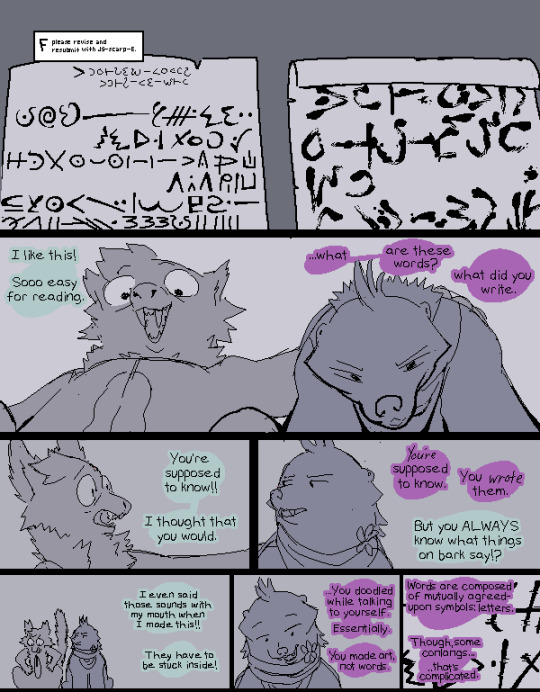
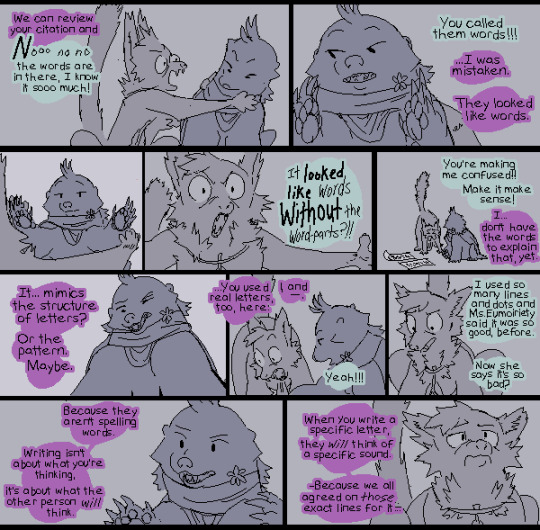
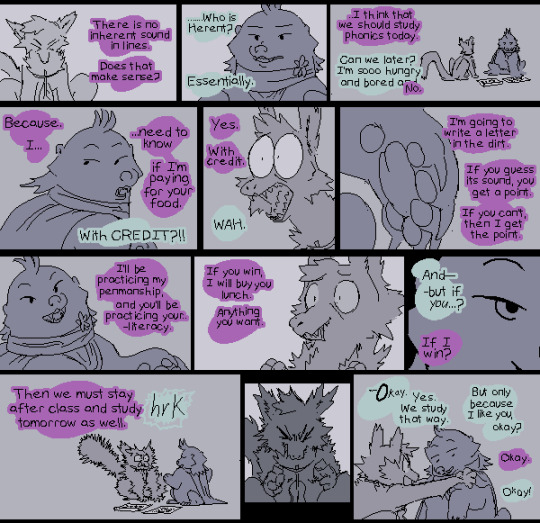
another little nofna style emulation comic i drew a bit ago that was primarily about why something can "look like words" when it isn't... it is possibly Legend's first time considering the involuntary nature of reading words. she can rationally know that she isn't looking at writing, but her mind continues to see words that she must try to decipher.
the comic ended up getting side-tracked, but i kind of just let these comics go where they go. it is the nofna spirit.
PS and Legend have probably only spoken several times at this point, as classmates. in my head, this is their first season of classes, and they have only just recently proceeded from practicing handwriting and making letters to writing out spoken word.
i imagine that letters and writing are not intuitive at all to people who haven't grown up with it. Legend knew how to read well before entering school. PS has not really internalized that letters represent sounds. she has seen her teacher or classmates speak words as they're writing lines, and later, other people can tell the words that were spoken while writing the lines. her penmanship is naturally excellent, and prior to this module, she was praised by her teacher lavishly.
i imagine that because MOST RODENTS become markscrafts, and rodents tend to be rather... prolific... in number. that classes for this profession would be fucking huge.
the teacher cannot individually dedicate attention to every struggling student, so the first practice is to pair two struggling students together who seem like they compensate each others' shortcomings and see if they can rehabilitate their grades together.
if students continue to fail despite peer review, that is probably the time where a teacher would talk to them privately or recommend a tutor, etc.
the classes also function by a "revise and resubmit" principle over an "extra credit" principle as it is the most direct way for students to figure out what they did wrong and the least amount of extra work for the professor.
their professor is a mouse; a tried to write the grade print small (called "mouseprint" in the canon).
PS's language here is very rough and strange; i imagine she has, at the VERY most, been exposed to common for only a year. she is maybe ~15-16 in age, psychologically. ever since i made her as a character, i assumed one of her core traits was a low drive to do work. she became a markscraft SPECIFICALLY because she did not want to put in the work to earn prestige or more credit. she picked the easiest possible career for her.
as a younger mind, and only recently introduced to the idea that she has to perform labor or GTFO society, her dislike of work is very obvious and she is not reserved about sharing it. she came from a life where she could volunteer to do small tricks for high value treats if she felt like it, and this life is comparatively brutal and demanding in her mind.
Legend's corsage is red star (Rhodohypoxis baurii) and PS's Leaf is a leaf from a large pineapple lily.
Legend is, conversely, probably 18-20 psychologically. idk, the ages are very weird with these animals. i've imagined her parents as highly Civilized people like XX's mother, but a little less strict. while many citizens of society hate wild people (presumably because many of them are serial killers who might serial kill them), not all of them do (example: nutsedge, who sympathizes with a Wild Hawk killing her classmates), and i imagined Legend's parents impressing into her rather strongly that she did not earn being born into a well-off family and physically gifted species.
of course, this didn't stop her from forming a superiority complex towards rodents anyway-- but, i think she's tolerating a significant amount of Weirdness from PS here that she extremely would not tolerate from someone she didn't assume was wild-integrating-into-society, from the constant touching, to the rude openness, the disdain for work ethic, the odd language usage, and the outfit that's essentially showing up to the study session in pasties and booty shorts.
it seems that in these stories, the animals attain a "fluent" level of speech in common relatively quickly (emancipation, secretary), somewhat influenced by natural talent; i think PS has a brute force spaghetti-against-the-wall approach that lets her just mimic as many phrases that she thinks are novel as possible. usually this is an option only available to toddlers who lack the self-awareness to feel embarrassment about constant awkward linguistic mistakes, but PS also has no cultural priming to be embarrassed of the behavior. you can see her parroting various things she's heard, such as "sooo much" as an emphasis phrase, and even "essentially" after Legend says it in passing. other more abstract phrases such as "with credit" or "okay" i imagine she knows simply by being exposed to them over and over again.
when the two get into deeper levels of literacy and markscraft classes, i imagine that Legend's knowledge of grammar and Big Words in general, combined with an ability to verbally express usually unwritten rules in the language, helped propel PS to a level of fluency that has her speaking like she was raised with it 99% of the time.
132 notes
·
View notes
Text
After referencing numerous diagrams, avian necropsy records, and my own prior knowledge of human musculoskeletal structure, I have devised speculative anatomical structure for Chozo.
We'll start small with my first attempts to properly chart basic skeletal structure from last year (seeing as how that's what I used as a jumping off point), then move on to the research-based stuff. I wanted to walk through the process of solving problems presented by the skeletal structure.
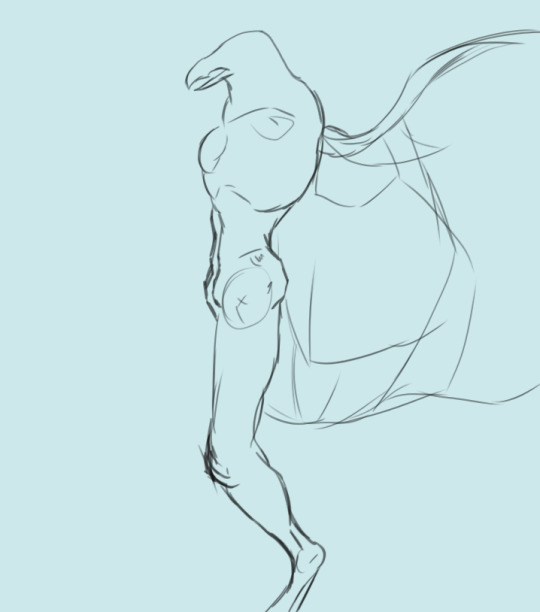

First we have a cursory look at the ribcage. Drafted June 7, 2023. Leaning into the more humanoid appearance.
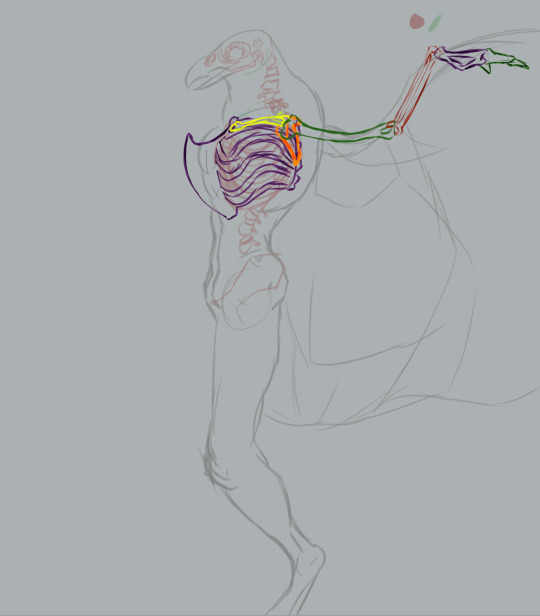
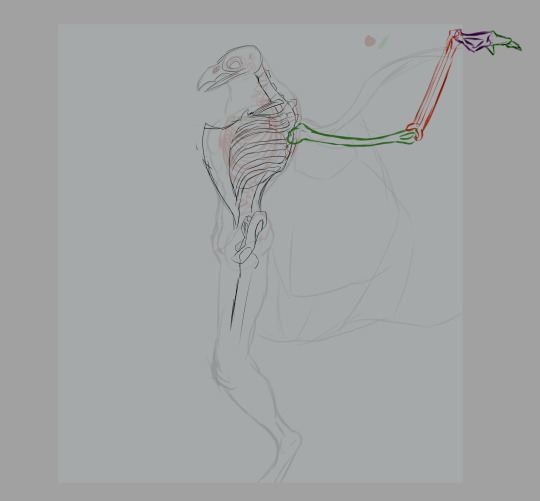
New addition, May 2024: a first shot at sussing out wing bones. These bones need to be much, much larger to accommodate the full breadth of the limb: this is just a rough outline. The skeleton also needs to bear muscles that are strong enough to carry the Chozo in flight, hence the new protrusion on the chest: a keel. Two variants of this new breast came out of this drawing session: one with a large keel that extends below the sternum and one with a normal keel.
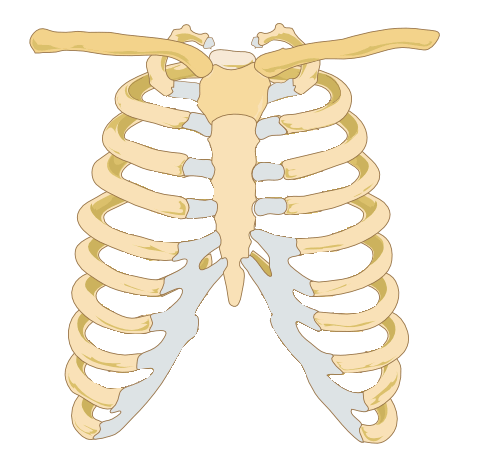
Image credit: Wikipedia
Human ribcages have this ridge along the bottom that the last six ribs are attached to (noted in grey on the image above). We're not doing that with the Chozo ribcage.
The sternum is the structure in the middle, which the ribs are attached to. See those two bones attached to the top of each side of the sternum, stretching away from the center of the ribs and forming sort of a capital "T" silhouette? Those are the clavicles. When you're drawing any humanoid form, the clavicles are an excellent landmark (and as I've been taught, the first place you should start on anatomy after you've laid out your pose, armature, etc).
It's also part of why wings are so difficult to suss out on Chozo skeletons. In birds, a bone that consists of a fusion of the two clavicles is a crucial part of flight: the clavicle bridges the gap between the ribs and the arms, and for birds, the wings are their arms. That's problem number one: effectively consolidating two pairs of arms on one torso.
We have a few bones to add onto the human skeleton in order to make flight possible for Chozo. First, we'll assume all bones are hollow. This makes them lighter, demanding considerably less energy to lift them off the ground in the first place.
I've modified the sternum to add a keel, which the base flight muscles are going to be anchored to.
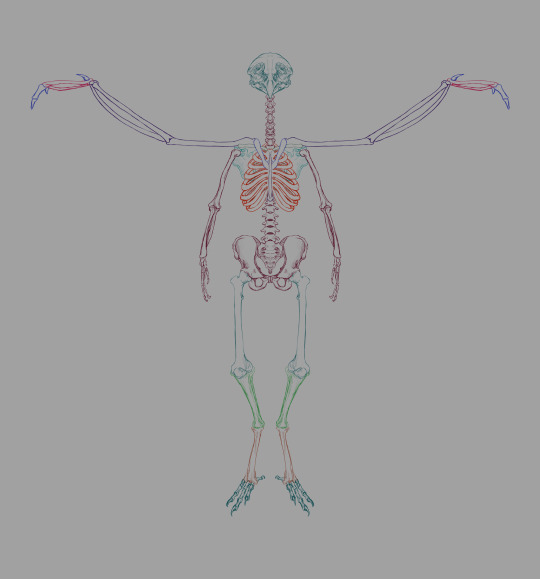
First pass at revising the skeletal structure. I made a few modifications unrelated to the wings. The pelvis is similar to that of a human, though a little wider to accommodate egg-laying. I may end up reworking the pelvis entirely to make it more bird-like, but I'm more interested in making those wings fit at the moment. Chozo have a human femur/patella, and avian lower legs.
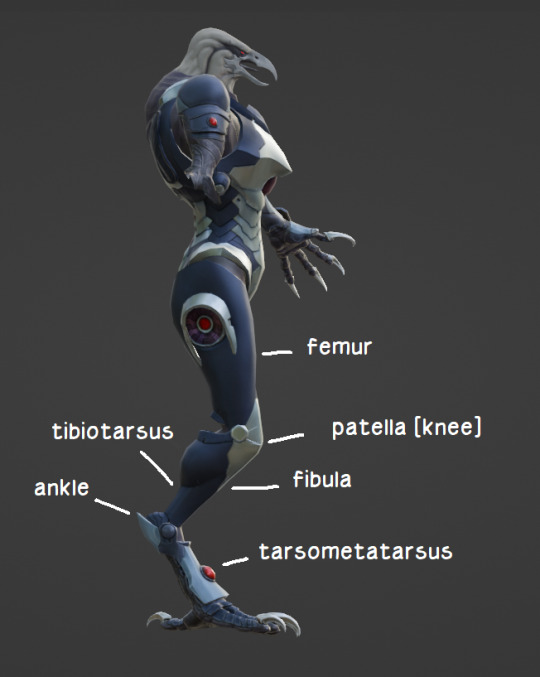
Here's a thing I slapped together in 3 minutes in January of last year to illustrate which bones are where for the layman. Onto different matters.
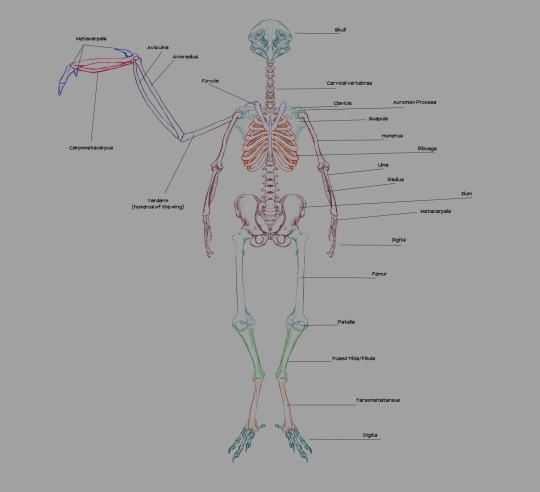
Skeleton, labeled.
Generally, the wings' humerus is attached to the scapulacoracoid, a bone attached to the keel that's sort of Y-shaped. That's how a real bird's shoulders are structured. Humans posses a scapula (shoulderblade), which has two protrusions: the acromion process and the coracoid process. The acromion process is where our humerus joins the shoulder. The coracoid process in humans is not exactly big enough nor ideally shaped to anchor flight muscles to.
At first, I had three ideas:
Invent a new bone attached to the keel that serves the function of the coracoid.
Modify the scapula to fit a new bone that anchors the flight muscles (the scapulacoracoid is analogous to the human scapula, after all).
Forego the keel and invent a bone on the spine that does the same thing.
To start, I added the furcula, a Y-shaped bone on the sternum, flanking the keel. Fun fact: not all birds have a furcula (better known as the "wishbone" in some parts of the world).
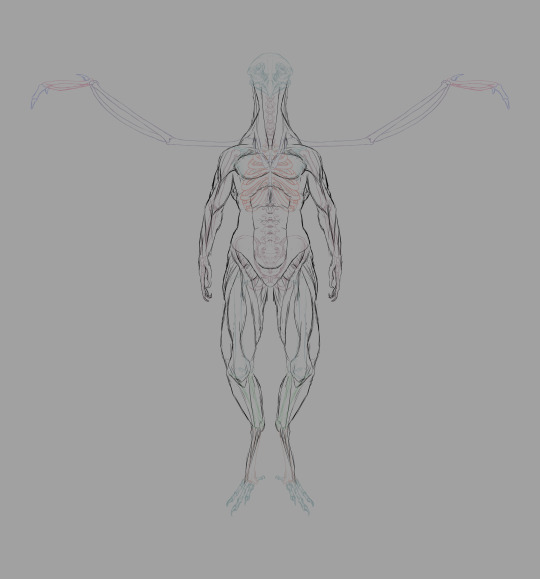
Real quick muscular structure layout sans flight muscles.
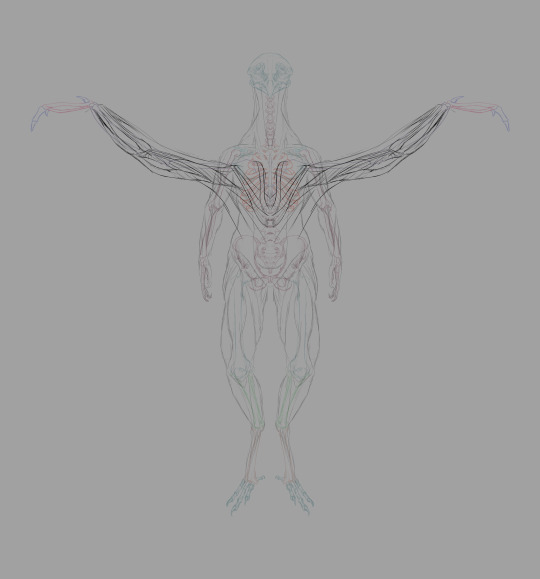
First pass at the flight muscles. Not the most accurate wing muscles in the world (neglected to depict the muscles near the tip of the wing, for one).
In this model of the musculature, a good deal of the flight muscles around the breast and torso are hidden by the pectoralis major, much like several non-flying human muscles.
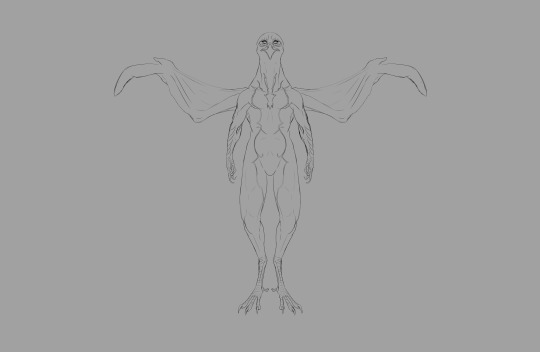
Flesh applied over muscle.
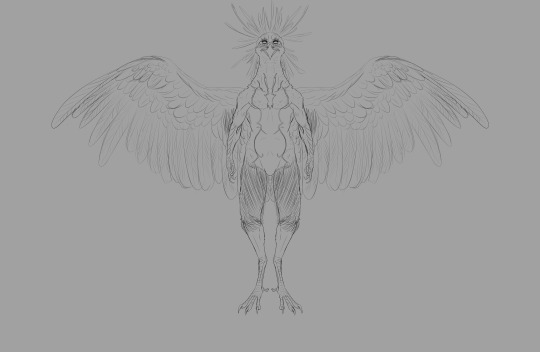
Feathers applied over flesh.
That was my first attempt at constructing the Chozo skeleton. You'll notice the wing bone solution is inelegant. See, wings are analogous to arms. Their metacarpals are finger bones. In order to give Chozo both arms and wings, we'll need to deviate from both avian and human skeletal structures to make the pieces fit together.
I can't make the flight muscles stretch comfortably over the clavicle: that has the potential to impede motion in the arms. My first idea in the second round of flight bone shenanigans was to invent a second bone that fit between the spine and the scapula, like shoulder-bound plate tectonics (working name "scapula trellis"). I wasn't wholly confident that I could configure flight muscles in a logical manner even with this setup.
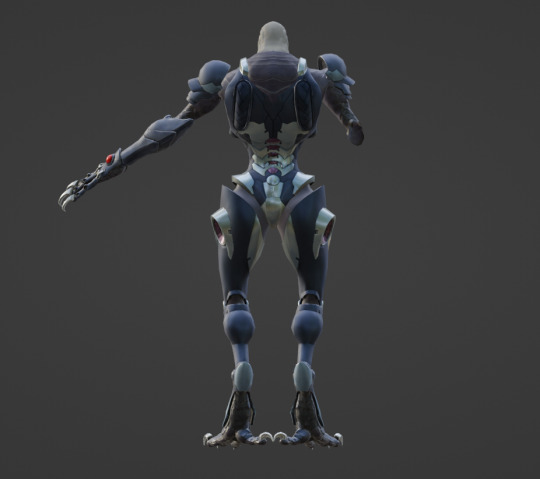
At one point I consulted Raven Beak's model. Note the patches on the back of the torso on the powersuit: that's where the wings emerge in phase 2. It looks like they're anchored to the scapula or an adjacent structure.
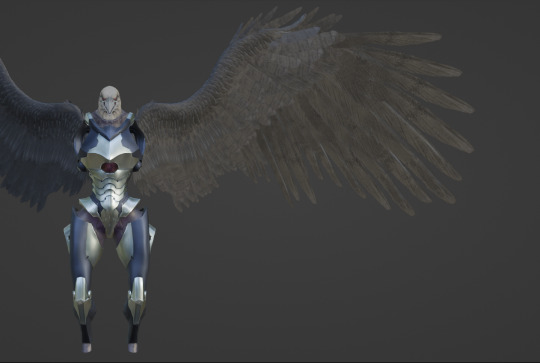
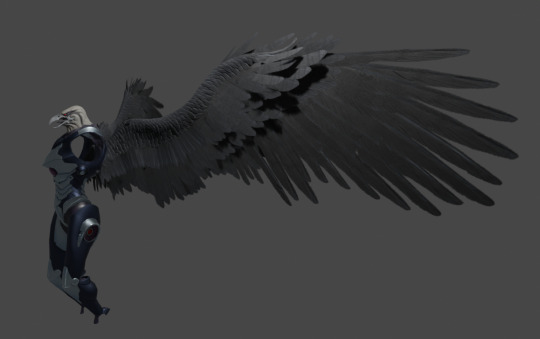
Barring the fact that his wings are absolutely ridiculous, I wasn't sure I could work with this. Gorgeous structures, but the feathers don't seem big enough to handle flight.
So I was left to brainstorm, and drafted up a few sketches for a second scapula to anchor the wings' shoulder joints to. I was more confident in this than I was the previous design, but I wanted to fish for ideas from other parts of nature.
Enter dinosaurs. Specifically, the Pteranodon with its shoulder girdle.

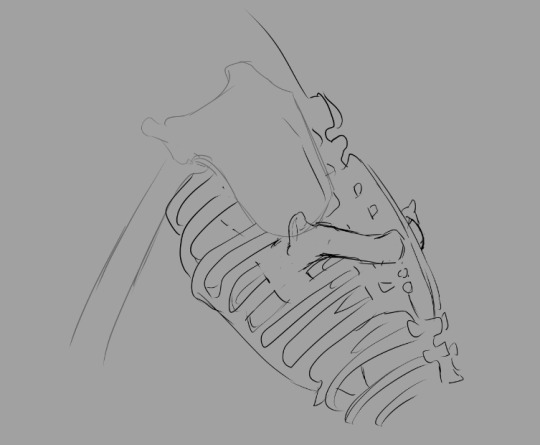
The addition of a shoulder girdle as an anchor for the yardarm (the term I'm using for the humerus of the wing, applicable only to creatures that have both wings and arms) seemed like a better solution. Positioning it below the scapula allows me to place the wings a little lower on the back, providing minimal interference between the two sets of limbs.
Whether we're rolling with the shoulder girdle or a second scapula, the intended result is the same: the wings have moved down on the back of the torso (personally, I'm digging the girdle, but the second scapula is on the table if anyone else wants to try their hand at this).
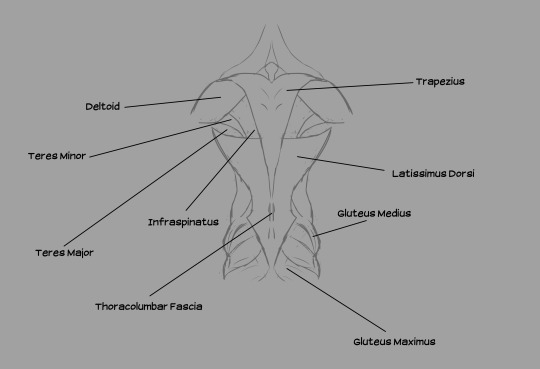
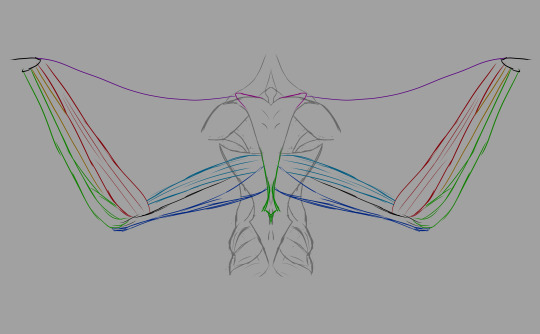
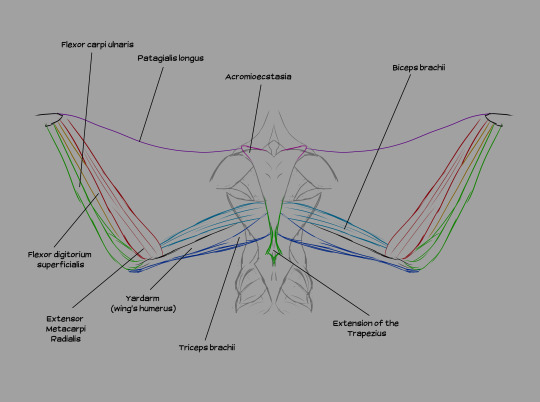
Muscles from the back, illustrated. Note the distance between the deltoid (shoulder muscle) and the wings. The shoulder girdle is situated in the lower-middle of the back of the ribcage.
A few notes: the acromioecstasia exists because the muscle that usually connects between the body and the patagialis longus on real birds is located on the pectoralis major. If I emulated that, we'd have flesh crossing over the deltoid to reach the front of the body, which would obstruct movement of the arms. We don't want that, so I moved that section of the wing to the back. We're compensating by adding additional musculature up front.
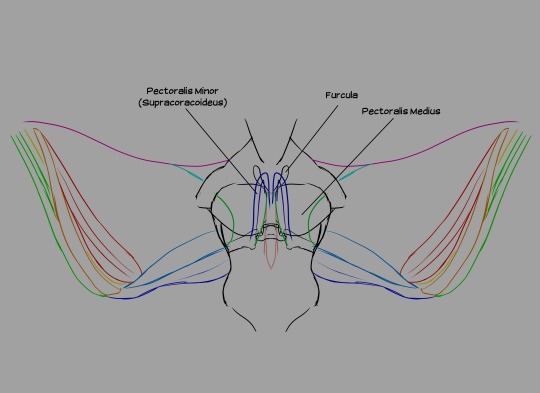
Wing muscles from the front. All three pectoral muscles are attached to the keel. The pectoralis medius is an extension of the pectoralis major, running beneath it and several other muscles. The pectoralis minor (also known as the supracoracoideus) lies beneath both the major and the medius. The pectoralis medius and major are responsible for the downstroke, while the supracoracoideus raises the wing between flaps.
Flight is very taxing on the individual. Power suit wearers actually have an easier time flying than non-wearers because the suit passively offsets the metabolic demands of flight with its own Energy.
It's important to note that these sizes are not necessarily "to scale". Chozo wings should actually be much bigger than my canvas permitted me to show. I had to keep increasing the size of the canvas on one of my files to accommodate a reasonable wingspan, but even that's not broad enough! I had to stop expanding the canvas for the sake of my CPU. If any muscles look too dinky or the scale seems off on some bones, that's why: I just needed to swiftly illustrate where things are.
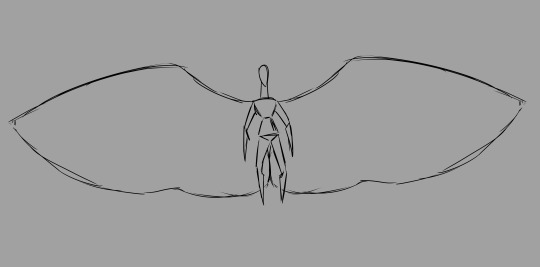
A Chozo's total wingspan should at least be twice the individual's standing height. Any smaller and there's no lift.
I still don't necessarily consider the wings "solved": if any speculative biology enthusiasts want to weigh in further on the subject, feel free!
After laying out the bulk of the skeleton (and before solving the wing problem), I decided to go a little further in my studies. Thus, we have organs.
First, the digestive system.
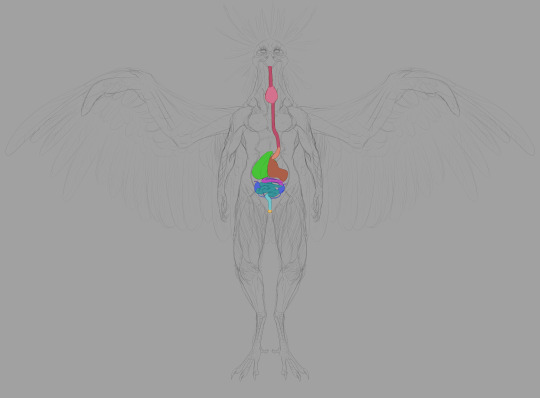
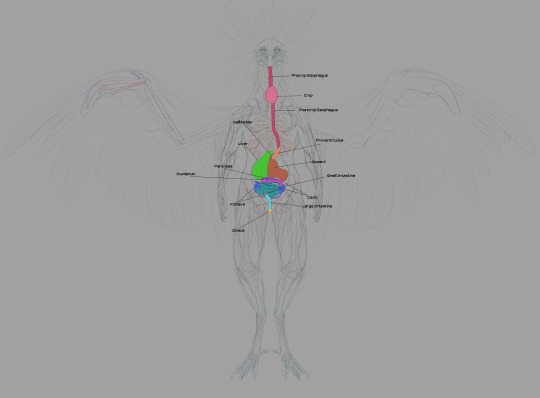
The esophagus is self-explanatory. Food goes in through the beak, traveling into the body through the esophagus.
The crop is used to store food: this is where digestion begins. Many parents regurgitate mushy, enzymatic food for their children from the crop. Very nutritious and promotes growth.
The proventriculus is the first half of the stomach: protein bonds begin to break down here. Gastric fluid produced here aids the gizzard in mushing things.
The gizzard is where the bulk of food-crushing occurs. Breaks larger matter down through transfer between areas within the organ.
The liver and gallbladder are crucial in digesting fats. Real bird livers have two lobes: the left is smaller than the right. Two bile ducts from the liver connect to the distal duodenum: the right duct is connected to the gallbladder. Chozo only need one.
The duodenum is the start of the small intestine, running in tandem with the pancreas. Pancreatic enzymes created by the latter assist in completing digestion, processing sugars, etc.
Digestion is finished in the other sections of the small intestine, where nutrients are absorbed.
Chozo kidneys largely resemble their human counterparts. Connected to the lower half of the gastrointestinal system. Urate is disposed of through the cloaca, transferred from point A to point B by the thin ureters bridging the kidneys to the large intestine.
Bacterial fermentation in the ceca extracts nutrients from plant material that can't be digested through enzymatic breakdown. The ceca and large intestine also reabsorb moisture, forming the solid portion of indigestible waste. The ceca are larger in tribes that eat more fruit and other plant products. Mawkin ceca are fairly small: they live quite an active lifestyle, and plant matter supplements their all-rounder diet with meat as the foremost staple.
The large intestine is the end of the line. Renal and intestinal waste is ejected here. The end of the reproductive tract forks to the distal segment to facilitate egg laying. Mammals have considerably larger large intestines than Chozo to dry out waste before expulsion.
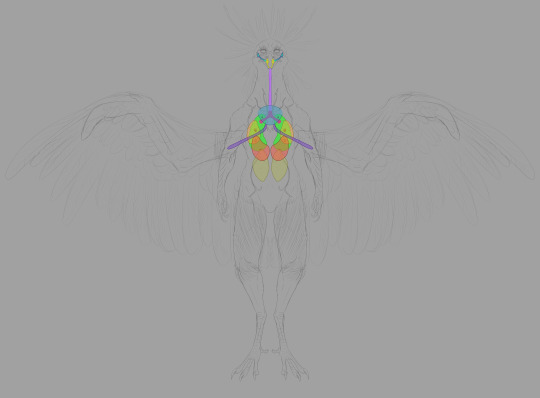
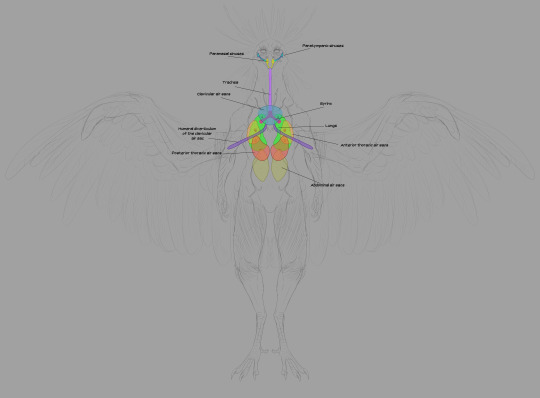
Next we have the respiratory system. The trachea takes in air and delivers it to the lungs. Unlike mammalian lungs, Chozo lungs are inelastic: they don't expand and contract. The air sacs do all the expanding and contracting: they're connected to the lungs through a network of bronchii.
The high metabolic rate required for flight demands a ton of oxygen, and Chozo respiratory organs are designed to do just that. The mechanics are fascinating but I won't take up too much of your time explaining the finer points. Wikipedia's write-up on the circulatory system of birds is a good place to start if you want to dive deeper.
The short version is thus: air enters through the nostrils, traveling into the bronchi through the trachea and syrinx (the syrinx helps Chozo vocalize). The bronchi deliver air to the lungs. When Chozo inhale, the posterior and anterior sacs expand: the posterior sacs take in fresh air while the anterior sacs fill with air that has already passed through the lungs. Air is constantly circulating through the lungs, and it's a one-way flow.
Parabronchii are microscopic tubes that run perpendicular to the blood capillaries. Parabronchii efficiently diffuse oxygen from the air into the blood.
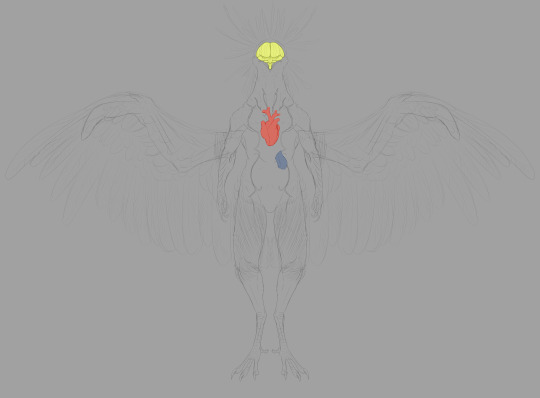
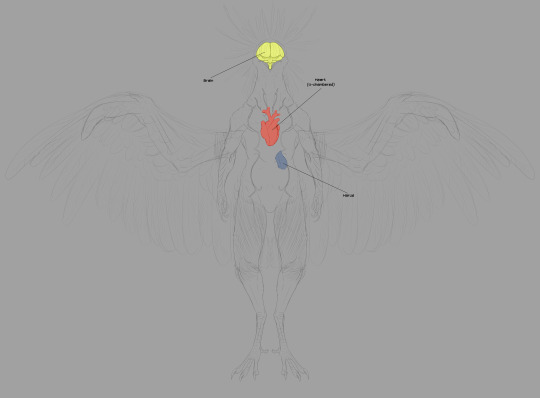
The next image set deals with a few extraneous vital organs. I'm not going to illustrate the nervous system nor arterial network, just as I neglected to illustrate all the bronchi in the respiratory system. That's a lot of tubes!
The circulatory system is pretty standard, but it pulls largely from Dread. Here's the thing: in the pre-boss fight cutscene for Raven Beak (aptly named 0086_comanderorbital_video_artwork_01.webm in the files), we see him contributing to Samus' biological makeup. His heart is set firmly in the center of his chest.
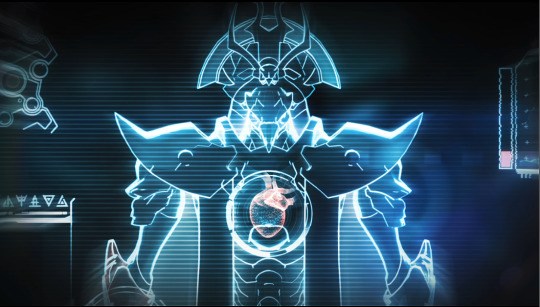
This is anatomically accurate to real birds! Bird hearts are placed similarly in the center of the chest, flanked by the left and right lobes of the liver (linked image is a labeled black and white illustration of a dissected pigeon, showing most of the major organs).
The brain is exactly what you think it is. No, the most interesting part of this last image set is the harus.
The harus is an accessory to the lymphatic system. You'll notice its proximity to the respiratory system. Lymphatic capillaries accompanying the parabronchi network filter more harmful atmospheric molecules into the harus, which makes use of specialized cells to recycle these molecules in a process that synthesizes ATP. In addition to this, the harus helps maintain the body's proper pH levels in hostile environments. This organ is what allows the Thoha to breathe in Zebes' toxic atmosphere.
Headcanon time: the majority of non-powersuit related genetic alteration done to Samus Aran in her youth is related to this organ: her respiratory system was altered with the proper instructions to produce specialized harus cells on their own without needing to transplant the organ. Samus can breathe on Zebes because her lungs can perform the function of the harus while she breathes.
Full-size pngs for everything are available on Ko-fi and Patreon. The canvas for this project was pretty big because I wanted to be able to capture the scale of the wings somewhat.
ADDENDUM, May 16, 2024: Chozo should have a modified pelvic bone that more closely resembles a synsacrum, not a humanoid ilium: I am a fool and completely forgot to make alterations in that department.
#headcanons#chozo anatomy#chozo#raven beak#metroid#metroid dread#metroid dread spoilers#gotta give props to friend of the blog Ivory who reminded me of ATP synthesis and suggested a second liver of sorts
101 notes
·
View notes
Text

Eleonara, the Mud Witch of Elgin
Lore under the cut vvv
*This universe uses a mixture of book, show and game canon!*
A graduate of Aretuza, Eleonara focused on her abilities as a healer, an herbalist and a skilled Geomancer. And after a failed stint in politics, the sorceress cut herself off from trivial court life and focused her attention on wandering the Continent, offering her services to small villages. Anything from healing, protection, and, perhaps most infamously: Stealing away women, children and the unfortunate in the night, guiding those in need to sanctuary.
Born to a Brickmaker and a local healer, Eleonara hailed from the tiny village of Elgin. Her home consisted of others also working with mud and clay, potters and sculptors, brickmakers and builders, and was hidden in the swamps of Temeria surrounding Lake Vizima.
El was a middle child with two older siblings and two younger, it was a poor family but a loving one. And the girl often spent time barefoot in the mud, tossing rocks further across the lake than her siblings and often excelling in Hide and Seek. In fact, it was actually quite easy for the child to make herself disappear. Whenever her siblings became cross with her, she’d vanish into the mist. Foot races led to opponents getting their feet stuck in mud turned hard like cement, and even bumps and scrapes on a little brother’s knee could be healed with a loving kiss at the cost of a nosebleed or a need for a long nap. Little did she know, this was the result of hidden powers coming to blossom from within.
Unfortunately, tragedy struck when bandits raided the village due to a rumor that gold had been found while mining the clay. Eleonara’s father was crippled from a devastating injury and, tragically, Eleonara’s mother and siblings were lost in the ensuing struggle. From a family of seven to a family of two, the wounds and eventual scarring ran deep. Eleonara’s father was never the same and carried around an everlasting sadness that his one remaining daughter could not heal. Not with all of the love and herbs in the world. The rift between them grew as time passed, only for their connection to be completely severed with the arrival of a teacher from Aretuza.
While Eleonara doesn’t blame her father for doing so, the man was far too uneducated to realize what was happening, the sorceress from Aretuza had been pointed in their direction after a complaint was filed regarding Eleonara’s magical stunts. The man, convinced that he was doing the right thing and that his daughter would be in safer hands, allowed her to be sold and taken to Aretuza. This would be the last time they would see each other.
Given that Eleonara was from a poorer family, she, like many of the other girls from poorer families, had to work twice as hard from within their prison at Aretuza. Providing sometimes dangerous and often grueling manual labor to support the school and its functions. All while not being allowed to leave nor while having any contact with the outside world.
The girl was *not* fond of Aretuza, growing to despise their teaching tactics and means of pitting girls one against the other as a means of achieving power and greatness. But regardless, she applied herself to her studies. She faced some ridicule for showing an interest in Geomancy, a stubborn branch of an especially stubborn and draining element. This ended up being something she ended up studying extensively and excelling in alongside healing and herbal tinctures. She graduated with average marks and was released into the court of an up and on the rise Baron. A Baron who, with his party of fellow men, had gathered and unified large swathes of villages and land together. It seemed a promising start, and with the right hand it could blossom into something more.
It would be Eleonara’s first, and last, dive into politics.
Eleonara was met with hostility, suspicion and dislike from the people. The Baron and his supporters treated her like a lap decoration more than a guide or advisor, and much of El’s advice and attempts to help were met with stubborn and narrow minded means of thinking. It soon became clear to her that these men were simply interested in power and conquest. Disheartened, Eleonara befriended the Baron’s wife, a village chieftain’s daughter taken and forced into a marriage she hadn’t asked for. They bonded over their shared hatred of the self appointed Baron and his men. And when fighting broke out between the men, Eleonara took it upon herself to take the Baron’s wife and her children and guide them back to her home village, there they could escape the country with an old lover.
Eleonara, feeling a sense of duty to Aretuza, remained. Even as the Baron was slaughtered and the power vacuum began, the sorceress staid with each leader until angry and abused subjects burned down the fortress. El simply let her image die with them, and left the ashes behind along with a vow to never work for higher powers again. In helping her friend escape, Eleonara had found her calling: She’d always been good at hiding things. Now she could help others do the same thing.
So she walks the continent, spending long periods of time out in the wilderness and among the earth. She hones her Geomancy and Geokinesis and seeks out the few masters of the element of Earth. However, she often peddles herbs and healing services to small villages and towns. And, occasionally, finding an orphaned child, a battered girl or an outcast, befriending them, and coming for them in the night to take them to a different place to begin anew. Daughters ripped from their families returned, children brought to sanctuary or loving arms of new parents, men left for dead sent to places of healing. It is how Eleonara heals her heart and makes her difference in the world she knows.
However, this has not been without incident. Those who recognize her mud stained clothes call her ‘The Mud Witch’. Handfuls of scorned husbands or hired thugs or witch hunters have been sent after her often. Most of which usually end up encased in thick and hardened clay. Many are under the impression that she whisks people away to be killed and used as sacrifices. And eerie clay figures often find their way into the homes of those who are ‘chosen’. Circles of clay figures can often be found in the woods, acting as a barrier to hide huts filled with supplies and provide temporary shelter for those who wish to journey to their new destination alone. Eleonara herself is a mysterious figure, one who doesn’t speak of herself often but remains level headed and calm in almost all situations. She defends her charges ferociously from monsters and men alike, and is not beneath trying to stand up to a Witcher or two in order to accomplish her tasks.
It is unknown how long she intends to keep doing this for. Perhaps it’s how she feels she can make the most use of her abilities. Or perhaps she’s simply looking for somewhere to belong herself. Regardless, befriending the Mud Witch of Elgin brings with it a deep bond and unwavering loyalty. One that is sure to last lifetimes.
#art#my art#mango does art#mango does ocs#the Witcher#Witcher#tw3#witch3r#witcher oc#Witcher ocs#oc lore drop AYY#eleonara
35 notes
·
View notes
Text
Summer 2024 travel plans and Language Guinea Pig Diaries
In August and September, I'm doing a bunch of travel to various European countries. In order, they are:
Glasgow, Scotland for World Science Fiction Convention (WorldCon), where I'll be on a panel about Languages as World-Building and doing assorted meetups
Helsinki, Finland for the Societas Linguistica Europea annual meeting
Tartu, Estonia for a colloquium talk on Applying Linguistic Methods to Linguistic Communication at the University of Tartu and a two-part workshop on lingcomm for participants of Methodological Excellence in Data-Driven Approaches to Linguistics (MEDAL)
Nijmegen, Netherlands for some meetings with linguists
Florence, Italy to visit friends
Madrid, Spain for the publication of the Spanish translation of Because Internet by Pie de Página
I hope to run into lots of interesting people at these events! If you're already in one of these places and I know you, including from the interent, feel free to reach out and see if we can fit something in!
This whirlwind list of events and places has also gotten me thinking: this trip is going to be a fun chance to learn some more about some languages! I'm already fairly familiar with Spanish and Scottish English (I doubt people will speak much Broad Scots to me with my Canadian accent), and I'm confident on my ability to brush up on them by a bit of exposure and possibly watching a relevant movie on the way there, but the other four languages are going to take a bit more doing. Here's my initial situation, in order of familiarity:
Italian - I studied it for two years in undergrad and spent about a week in Italy shortly thereafter, and by the end of the week I was finally beginning to feel like it was starting to "click" but then I haven't really touched it since then. So I feel like it would come back with exposure but I wonder if there's something I could do in advance to help it come back sooner/faster rather than taking the whole week of being there again
Dutch - I went through the whole Duolingo tree on rapid-speed back when you could skip through lessons for new material only and not practice drills over about a year in 2019-ish just for fun and as an excuse to look up lots of Germanic roots (I studied German before I knew any linguistics so it was fun to triangulate there). Never actually been anywhere Dutch was being spoken but I did find I could get the gist of youtube videos about linguistics in Dutch so it probably needs "activation" similar to Italian
Finnish - No background except for a few linguistics factoids (case! vowel harmony!), and that it's a Uralic language (related to Hungarian but not to any of the Indo-European languages, so this is a fun chance to learn some things about a language family that's unfamiliar to me)
Estonian - Also no background, also Uralic, clearly the fun thing to do would be to learn enough bits of Estonian and Finnish that I could compare them with each other (also since I'm meeting with linguists in both countries, this would be a fun topic for small talk conversation)
At the same time, there are a lot of language learning strategies floating around out there, and I have two nearly matched pairs of languages on this list: Italian and Dutch, both of which I am pretty good at cognate languages for and have studied some a while back, so I could test two activation strategies, and Finnish and Estonian, both of which I have essentially zero familiarity with, so I could test two strategies for getting somewhere near a basic functional ability.
I have about a month until I start this cycle with a flight to Helsinki. One month, four languages. What could possibly go wrong?
Here's my tentative plan so far:
Activation, Italian and Dutch - I'm pretty sure what I need for these languages is largely as much audio imput as possible (given what's feasible around like, all the other things going on in my life). I've decided to aim to watch one or two youtube videos in Italian per day, focusing on relatively concrete, daily life topics (such as gelato making) and to listen to one episode of a podcast in Dutch per day, aiming to get through the back catalogue of Kletsheads, a podcast about multilingual children.
Why these strategies? Well, I'm meeting up with linguists in the Netherlands but not in Italy, so it makes sense to try to learn more linguistics vocab there. Also, I'm curious about the effect of medium between video and podcast: will being able to see people talking and what they're talking about have much of an effect on how much I can understand? Will I find it easier to integrate one or the other of watching videos vs listening to podcasts into my life at a practical level? Plus, will concentrating on a single, more academic topic vs watching a scattered, unsystematic list of videos have effects on my vocabulary?
Basic function, Finnish and Estonian - I'm probably looking for some phrases to say to people in shops and restaurants and the ability to pronounce things written on menus adequately and match heard words/placenames to written versions on signs. I started doing a very minimal one lesson a day on Duolingo for Finnish in January, when planning for this trip started, for the very simple reason that I was already familiar with Duolingo and it doesn't have Estonian, so I decided to just start by doing a thing I was familiar with until I got around to doing more research. I've been casting around trying to figure out a source of basic Estonian phrases online when a friend mentioned learning French on tiktok, so I searched for "learn estonian" and voila! I think I'll also aim for a video or two of Estonian phrases per day but I want to do more rewatching than with Italian or Dutch, since I'm aiming to remember specific common phrases. So maybe one rewatched video and one new video, per day? They're shorter on tiktok than on youtube.
Why these strategies? This is a comparison of Duolingo's more systematic approach with lots of repetition and gamification and word-by-word translation in a relatively sterile environment versus a more organic and free-styling approach with more grounding in real people and faces and full phrases where I'm not really trying to understand the individual words. There are lots of factors to compare and it's not a completely fair comparison since I started Duolingo in January and I only thought to start the TikTok idea this week, but hey, learning anything still counts as progress.
Summary: I have four languages, each focused on a different app: YouTube, my podcast app, Duolingo, and TikTok. Hopefully for the video apps, this will help their algorithms kick in and start recommending me further useful videos. The difference between the two video strategies is that for Italian, I'm watching monolingual videos that are aimed at people who already speak Italian and just want to learn something about the topic, whereas for Estonian, I'm watching bilingual videos aimed at English speakers who want to learn some words or phrases in Estonian.
Am I going to get these four languages mixed up? Probably! I'm hoping that choosing a different app/strategy for each is a little bit helpful on that front.
Do I think these strategies are optimal? Probably not! But I'm aiming to choose things that feel relatively clear to implement consistently, rather than getting bogged down in researching language learning methods instead of actually getting exposure to the languages. I'll probably do a basic "look up some key phrases and try to learn them" a day or two before entering each place too. And maybe shift other aspects depending on how things are going, stay tuned!
At any rate, I figured it would be more fun to blog about my attempts to use myself as a guinea pig for a few different language learning strategies here than to just do it in my own head (and hopefully help me with staying motivated). And maybe people will have tips of either language learning strategies that have worked for you in general or specific ideas for these particular languages, so this is the beginning of a series that I'm calling #Language Guinea Pig Diaries and future posts will also be posted under that tag!
#linguistics#languages#language learning#learning languages#foreign languages#language guinea pig diaries#italian#dutch#finnish#estonian
46 notes
·
View notes
Text
My brain feels like it’s soup rn but here are some facts about the different types of marionettes for my Anderson Rescue AU because thinking about the logistics behind fictional species is one of my favourite things to do
More facts and information to come when it does. If you want to ask questions about how something is run or how your favourite ended up at the rescue, throw an ask my way.
The Marionette
Taxonomic name: vivus pupa superior
Marionettes are a small omnivorous species with a human-like appearance. In modern times, populations can be found all across the world, although where they originated has yet to be determined.
Marionettes come in two distinct groups, denoted as either ‘Wild’ or ‘Urban’. Despite these names, both have domesticated and feral populations.
It must be noted that ‘Wild’ does not mean aggressive, nor does ‘Urban’ mean friendly. Instead the following terms are used:
‘Domestic’ = born or prolonged time under human care. These Marionettes are the friendliest to humans and follow our behaviour (eg circadian rhythm) the most. [Includes Lady Penelope, Steve Zodiac, Colonel White, Mike Mercury]
‘Socialised’ = not owned or reared by humans, but have spent enough time around them to hold no fear. Friendly but still very much feral [Includes the Stingray lot, likely some of Spectrum]
‘Feral’ = little to no human exposure (or at least positive), the ones who have spent their whole lives either in the wild or on the streets. ‘Stray’ is commonly used for Urban Marionettes, but is not a fully recognised term. [Includes Zero, Venus, Jeff Tracy]
The Wild Marionette is identified by its large head and hands, as well as being slightly larger than their counterparts, a strange bucking of trends found in other species.Suspicious by nature, studying feral specimens has been a difficult task, however advancements in technology have allowed us to learn more about their kind:
-Wild Marionettes are a mix of diurnal and crepuscular, being active through the morning and late afternoon-evening, but retreating to sleep at midday. This behaviour may have two main functions; to avoid both being out at the height of predator activity and the hottest part of the day. The circadian rhythm of a Wild Marionette can gradually be altered however.
-Whilst most of their lives are spent in solitude, Wild Marionettes are known to form loose social groups that will coexist peacefully and chase away threats. Parents will often work together in “coalitions” to look after their young. When it comes to finding a partner, they mate for life.
-When alone, evidence suggests that they spend the first weeks and months rearing their young in hand dug burrows.
-Wild Marionettes have excellent night vision, but struggle with translucent materials. It is not uncommon for them to walk into doors and windows. They can, however, recognise their own reflections.
-Wild Marionettes are foragers and small-time hunters. When feral families are observed in the wild, parents will often be seen showing their pupplets how to find food. In domestic individuals, this hunting drive can be satisfied with games that involve searching around the house.
-When it comes to habitat, places with plenty of opportunities to hide are preferred. The most popular is deciduous woodland, although heath and moorland can suffice. This appears to be because once the burrow has served its job, Marionettes will hide their pupplets in leaves and grasses if they have to be left unattended.
-A Wild Marionette may occupy a ‘range’ in which they travel, coming and going from place to place as they please. It is not uncommon for these ranges to overlap, resulting in either territory disputes or coalitions.
-Historic evidence suggests that our relationship with Marionettes dates back many centuries, occupying a similar role as the domestic cat.
-It is believed that Wild Marionettes may have been the inspiration for folk tales like the British Hob
Smaller than their wild cousins and with more human proportions, the Urban Marionette is a far more recently documented specimen, although it is possible they have existed for longer than we believe. Thanks to their proximity to urban centres, observation and study has been slightly easier:
-Unlike the Wild Marionette, Urbans appear to have no set time of activity. Instead, their activity out of sight of predators has allowed them to operate completely randomly.
-Similarly to Wilds, the Urban Marionette will form social groups. These are more closely knit, spending a deal more time together and existing with a stricter hierarchy. Coalitions are also very common.
-Due to be more social by nature, Urban Marionettes spend less time isolated with their young. They are however, highly aggressive and territorial during this time, only allowing litter mates and partners near.
-Urban Marionettes are perfectly capable of seeing and understanding transparent materials, likely due to greater generational exposure. However, this has come at the cost of their night sight, which is poorer than a Wild Marionette.
-Despite popular belief, feral Urbans are very hygiene conscious, spending hours of their day keeping themselves and each other clean.
-Urban Marionettes are scavengers, less skilled in hunting but with more adaptable digestive systems. This does not mean domestic pets should be fed anything and everything.
-Urban Marionettes are not fussy about their environment, but will spend lots of time organising and cleaning their favourite areas. Small, strangely clean areas in urban spaces are a good indicator there is a Marionette nearby.
-Although contested, it is believed that Urbans may have been the first to be domesticated. Other theories suggest they are the descendants of Marionettes that were domesticated and abandoned.
#thunderbirds#stingray 1964#captain scarlet and the mysterons#fireball xl5#supercar#supermarionation#living marionettes au#Anderson Rescue AU
11 notes
·
View notes
Note
Now I’m curious of some of the other characters upbringing, if you could give a short summary (or long, I love reading your rambles!!) of each of the Fated 15’s upbringing, what would they be like?
I'll go down the list ^^.
Tim's upbringing was just fine. A bit of an overprotective mother, but a loving and caring one. She really drilled home the morals of hard work & hospitality into him growing up. He and his mom are very close, especially because they're all they have at home.
Hannah couldn't complain about her childhood either. It was a very chill upbringing. She takes heavily after her dad-- he's a cool and relaxed kind of dude, handy. Their whole family (Mother, Father, Hannah, Step-brother) are big on helping out others and spend a lot of their free time in community service, and that's had a big effect on how she interacts with others, especially post-Fault.
Brook, as I'm sure most of you know already, grew up with a very very traditional, anti-tech family. Not a lot of exposure to the outside world, her and her siblings were schooled on their property and were taught a lot of untrue things about the world beyond their small town. But, her childhood was not bad. Her family is very loving-- conditionally so, but she's never had an issue falling under those conditions-- and perhaps a little overbearing at times. Her and her older siblings have all learned to hide certain aspects of their lives, thoughts, and desires from their parents as a result of their aggressively traditional ways of thinking. Brook's thing was sneaking out at night, a habit her parents believe she's grown out of (she hasn't).
Gary's upbringing was both lavish yet harsh. He's a prince after all, taught many skills and hyper-specific manners, had high expectations, all of which he failed to excell enough at for his dad to ever be proud of him. His dad and step dad always seemed like they were watching and judging everything he did. He was prone to lashing out, running away for short periods, or intentionally causing issues just so he could be grounded and be alone for a while. It's left him with a lot of bad habits and poor emotional regulation. Never taught or praised for doing the right thing, only punished for doing the wrong thing.
Lauren's homelife was nearly picturesque. Loving parents, bratty older sister but never anything more than a bit annoying at time, an incredibly large and decked out home in a gated community with friendly neighbors and seriously, nothing to complain about. She simply had interests that never aligned with her family's, and even though they supported her she convinced herself that they either didn't understand, or that they were overbearing and controlling. They weren't. She just functions on a different wavelength and made it their problem, lmao.
Elliot's upbringing was a little rough, his dad was rarely there and a bit of a deadbeat, and his mother was a hard worker trying to make enough to support their family. Elliot had to raise his younger brother which matured him quickly, but he missed out on a lot of his later childhood as a result. He often found himself in a lot of risky situations with nobody around to provide some foresight, so he's lost and learned a lot throughout his life
Tanner's upbringing was kind of boring. His family was never super close, it just wasn't really in their nature. Often they would be off doing their own things rather than participate in family gatherings. Even meals were typically enjoyed alone or distracted by things like television. There wasn't always much to do at home, and he grew to be very tolerant of inactivity. He spent a lot of his time in his room listening to music, or getting up to weird or questionable things late at night with April.
April has always been a contrarian, and even in instances where she wasn't, her parents grew to expect it from her and acted accordingly anyways. There's always been a lot of arguing in her family, and as a result she has a hard time not defaulting to arguing or just straight up opposing a statement, even in the event that she does agree with it. Her brothers were often cruel towards her and never got in trouble for it, and she never really felt like she belonged at home growing up.
Leon's life was pretty free. He grew up in the very small nowhere town of Lystrike with parents who had him later in life than most, so he was raised by not just them, but as they got older and couldn't always keep up, the greater community as well. You'd hear no complaints from him about his childhood, he felt safe in his town and stuck hard to the good morals it taught him.
Rachel's upbringing was pleasant, her family was close-knit and sociable. Despite magic being quite the uncommon thing to learn as a talpian (and even questionable depending on where you live in the underworld), her family was always supportive of her. They raised her well and she felt more than confident in moving out when she was old enough, and always kept in close contact with them after she left.
Bonnie's upbringing was hard. Her mother was frequently ill, and her father worked long days at sea. She took care of her mother from a young age, and when she wasnt, hung around the docks either with or waiting for her father. She had to be the one to acquire the family's goods and necessities more often than not, and her home town was not a particularly safe one, especially for a young girl to be walking around in all alone. She never complained though, not once. She was lucky to have a home whereas many others in her town did not.
Michael's childhood was loving. He's always been a bit babied by his mothers, though they've laid off it a little in more recent years, and so he tended to be a little more ignorant and immature growing up. He went through an oppositional phase in his teens that made his home life a little more tense, but that's kind of on him-- his mothers have always been supportive and given him everything they could for him to live a comfortable life.
Samantha's, as stated a few asks ago, was lonely. Life lessons were missed or taught begrudgingly through house workers, or rarely learned the hard way. She has grown cautious of the unknown and gets a bit uncomfortable stepping out of her comfort zone, because nobody at home has ever taken the time to teach her some confidence. Yuan helps her through this, by virtue of being a huge fucking dragon.
Debbie's upbringing wasn't awful, but not very fun either. Raised soley by her dad who was a militant control freak, she could hardly be herself at home. She learned to become proficient at sneaking out at night, and gets away with all of her rambunctiousness when her father is away with work. A lot of her life has involved being yelled at or around, or walking on eggshells to avoid upsetting her dad-- especially in her earlier years. If there is one thing she got from her dad, it'd be her volume control.
Vilmr was raised as best as he could by Maja, a lady who has never had any children of her own. She's given him a roof, enough food, plenty of wisdom, and some harsh love here and there. He's always been a hard child to keep tame, but respect and discipline have been constant lessons throughout his upbringing and he's always worked hard to make her proud, even if he finds himself being problematic from time to time.
#brambleramble#some of these are pretty summarized#like debbie wasn't just nonstop yelled at all her life. she did have some decent times with her dad#but overall that's just what it was like yknow#or like tanner. not close to his family but it's not like they didn't get along and hang out every now and then.#a lot of nuance in their lives but i tried ro generalize it to the biggest aspects
31 notes
·
View notes
Text
Burnt Leaves
Simon "Ghost" Riley x GNC Reader
SFW / Fluff & Comfort / No Dialogue / TW: Drug abuse mentions, mildly unhealthy coping with insomnia, one off-handed joke about dying
Summary: You deal with plenty of bullshit as is, and insomnia is just the straw threatening to break your back. You have your ways to deal with it, though. Seems like the skull masked lieutenant needs a new coping mechanism as well.
I may write more if people actually enjoy this, also i wrote this at like 3 am and i am dealing with insomnia myself, pls excuse if it sucks lmao
Being in the military was probably your best option. You weren't small or weak, you had quite a ways to go, sure, but you held your own. That's what initially impressed your training captain. You had a drive despite being depressed as shit. Which, maybe you lied to your recruiting officer. And the doctor. And your training sqaudron. But what's a little lie compared to staying in that drug den you reluctantly call home?
The harsh drills and tense, full body aching was nothing to you. Not compared to watching your mother be strung out on a stained, burned, broken couch while being left in the drug dealers care. Hell, or even when you had to help her find a dehydrated vein with a short and dull needle. Perhaps something that you considered a life saving skill, but it made you feel disgusting if you thought about it for too long.
You've been shifted around a few bases when you were needed, seeing as you were sort of an everyman. Excelled in the maintenance of weaponry, one hell of a mechanic, and maybe a few things you knew how to do that were definitely against the Geneva Convention. To be fair, though, if you had to decide between dying and using a makeshift gun that was severely out of regulation, you'd take your chances in court.
But all of this shifting around and half assed childhood you had lead to even more goddamn problems you didn't need. Often, maybe every few nights every single week, you dealt with insomnia. Bad weeks had you trying to fight the uncomfortable disorder every night, but you lucked out with having to deal with it half the time usually.
It was always so uncomfortable. The inside of your skin felt like it was covered in small pyramid-shaped cones that pressed into every nerve where there was pressure. Your eyes were heavy but never heavy enough to induce sleep. Your mind would never fog up the way it was supposed to. And it drove you absolutely crazy.
You had a few ways to deal with it, as most chronic sufferers do. Sometimes you accepted it and laid there until pure exhaustion won. Your worst option.
Most of the time, though, you'd already spent a few hours hoping, tossing and turning in restlessness before getting up. You'd lace your boots and try to walk it off. Speed up the exhaustion process manually. And it worked maybe 50 percent of the time. And you'd collapse back into your bunk, shoes still on and pillow over your head, and get just enough sleep that you wouldn't hate yourself in the morning.
And the nights that even that didn't work, you'd find yourself in the kitchenette of the rec area. You'd stare desperately at the coffee pot you were using to heat up water while you waited to choke down a bland, bitter chamomile tea. You couldn't stand tea on its own. You didn't have a sweet tooth, but you could accept when something needed a little bit of sweetness.
This often settled you down enough. The overwhelming tired made you cry in the barely lit room while your tea steeped, palms pressed into your burning eyes as you wished you'd just fucking sleep. And you'd stop. You'd drink your tea. And get enough sleep to function.
And you fell into this pattern and habit.
Until this one mother fucker.
See, you ended up being called in to aid in the upkeep up vehicles and guns at a fairly large base that served as home grounds to plenty of "real soliders". You didn't pay mind to many of them, but Captain Price's team at least treated you decently since you were the one making sure their guns jammed significantly less. However, Ghost creeped you the fuck out.
That teams lieutenant was horrifying to you. He stood way too tall, was way too broad to move that fucking quietly. He held this awful aura to him that was completely unreadable. And he barely ever spoke to you in a way that didn't feel like a back handed... well, you wouldn't even call them compliments. The man would stare more often than breathe, just watch you move about your job from the doorways and wait for you to notice he was there before declaring that he would have been able to kill you six different ways by that point. You've been able to get that number down to four, at least.
And for some reason. This also included your overstimulated and tired crying time at the coffee pot at 2 a.m. as well. It seemed like it was his third time just watching you when he spoke up for the first time, mostly just asking what the hell you were doing. You'd jump out of your skin, a blessing of a feeling if it didn't shoot unnerving shivers down your spine, and stammer out a half coherent response about tea leaves. And then he just... stood there. Watching you drink your tea and then leave after you were done.
At some point during this routine, he'd started to invite himself to sit across from you at the small table. He never really struck up conversations, though you swore you could see amusement in his eye as you made faces at the bitter tea. He knew you were burning the leaves, but he couldn't tell you that. Listening to another person rip into him about being British was very low on his to-do list.
This became comfortable. You began to tolerate his shadow-like presence. Maybe even enjoyed the silent company. You could guess that he was suffering the same just from how tired his eyes looked past the mask. Maybe he too found solace in a shared solidarity that you two really haven't expressed. It was bittersweet. Two barely functioning and sleep deprived people finding a space to relax, lit only by a half burnt out overhead lamp. Maybe, even if a bit selfishly, you had begun to go a little morr often judt for the company of a man you didn't know the actual name of.
Ghost never left before you, but only arrived after you began heating some water. He never had a cup himself, sat himself in the same chair, and limited himself to a handful of yrs or no questions a night. You didn't mind.
But he once again found a way to disrupt this routine.
You were reaching up to grab a mug from the cabinet above you, your other hand grabbing the coffee pot of hot water. You heard him move, which honestly should have been your que to turn around, and you felt him standing directly behind you. He covered your hand on the handle with his much larger one and practically forced you to let him grab the pot. He grabbed two mugs and moved off to the side, only meeting your eyes when you didn't move.
What ever fucking compelled him to do that, you had no idea. You were staring with bloodshot eyes and still even had your hand vaguely where the pot was. He simply nodded his head to the table and turned back to the mugs.
Guess you weren't making your tea? Deep down, thr angsty teen part of you hoped it was the forever sleep kind of deal. But that was dumb, so you shook your head a little to ignore that.
Ghost set your mug down on the table before sitting himself across from you, lifting his mask up enough to take a drink.
You've yet to see him do that, so your brain was just kind of off at this point. You stared, not that you meant to, as the man replaced his mask and set his mug down, staring back at you with a quirked brow. You looked down in a daz3 before grabbing your own mug, taking a long sip. Did he make a different kind of tea? Why the hell did it taste so... so much better? Your confusion actually earned you a small laugh from the other, a quiet, muffled chuckle from under his mask. That shouldn't have given you butterflies. He still scared you, after all.
He never explained himself, but from then on, you left the tea making duties to him and he didn't seem to mind. You fell into the pattern of getting there before your insomnia got into full swing every night, starting the water and getting the mugs. Then your midnight partner would show up and handle the rest.
As much as the mask gave you the creeps, it was growing on you. Like the previously bitter tea.
#crowwrites#uh yeah i kimda wanna write more and post my drabbles here#do with it what you will#idk if ill be taking requests yet#but im gonna hopefuly be writing more for a ton of stuff#maybe one dayy ill put this stuff on ao3 too#simon riley#simon ghost riley#cod ghost#cod simon riley#cod simon ghost riley#x reader#ghost x reader#ghost x you#ghost x y/n#no dialogue#tw: drugs#cod fluff#call of duty#cod modern warfare#cod mw2
47 notes
·
View notes